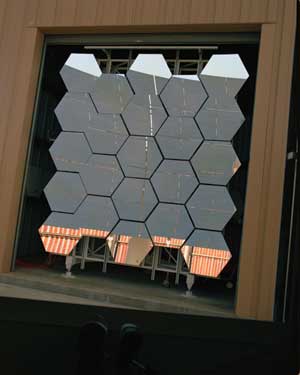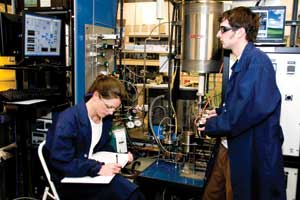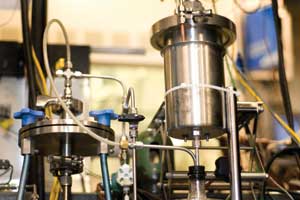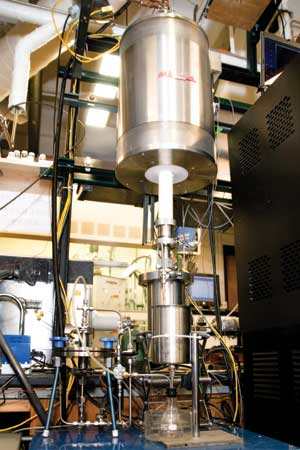Solar-Powered Biomass Gasification













January 1, 1970
BY Jessica Ebert
One of the drawbacks of biomass gasification systems is that the energy to power these reactors is typically drawn from coal-fired power plants. To produce a truly carbon-neutral, or even better, a carbon-negative fuel, the electricity to turn waste biomass feedstocks into a syngas, which can be further processed into fuels, must come from a renewable energy source.
To that end, a team of scientists including engineers and horticulturists from the University of Colorado in Boulder, Colorado State University in Fort Collins and the National Renewable Energy Laboratory in Golden, Colo., have embarked on a project to develop rapid solar-thermal reactor systems for the conversion of biomass to syngas. The project is being funded by a three-year, $1 million USDA and U.S. DOE grant, which was announced in early March as part of an $18.4 million package to fund 21 biomass research and development demonstration projects.
The collaboration is led by Alan Weimer, a professor at CU-Boulder and executive director of the Colorado Center for Biorefining and Biofuels who worked for Dow Chemical Co. for more than 16 years before pursuing a career in academia. At Dow, Weimer worked in the area of ultra high-temperature processing for the synthesis of fine materials like tungsten carbide, which is used in the manufacture of mining instruments and other high-tech tools. The materials were generated by flowing chemical precursors through a graphite reactor tube that is heated indirectly by electricity.
When he joined the university's Department of Chemical and Biological Engineering, his first project was an extension of his earlier research, but rather than using electricity from the grid, his work involved using concentrated sunlight for chemical processing. "The process looks a lot like the technology developed at Dow except instead of heating with electricity, we use sunlight," Weimer explains. "We can achieve the same temperatures without generating any greenhouse gases."
During these early studies, Weimer and colleagues established a relationship with the engineers at NREL who had designed what's called a high-flux solar furnace in the late 1980s.
The furnace facility sits on top of a high, barren mesa and consists of two main components: a flat mirror called a heliostat that tracks the sun as it moves across the sky and a primary concentrator, which consists of a series of 25 curved, hexagonal-shaped mirrors. The large, 32-square meter (38-square yard) heliostat reflects sunlight onto the primary concentrator, which focuses the sun to a single point. "It's basically similar to using a magnifying glass to concentrate sunlight to a point, although we use mirrors instead of lenses," explains Carl Bingham, staff engineer at NREL. This concentrated sunlight, which has been reduced to a beam measuring 10 centimeters (4 inches) in diameter, is reflected a second time at a target area inside the test building where researchers run their experiments.
"The original intent was to see what we could do with highly concentrated solar radiation," Bingham says. By tightening the focus of the sunlight or increasing its concentration, temperatures pushing greater than 2,000 degrees Celsius (3,632 degrees Fahrenheit) can be reached. "The idea is that heating things with concentrated sunlight gets things very hot, very quickly," he says. In addition to scorching temperatures, the furnace allows for the selective heating of the sample surfaces.
Bingham, who has worked on the solar furnace nearly since its inception, explains that the early experimentation involved materials synthesis including the application of films onto various substrates, the formation of silicon crystals, the development of new methods for bonding metal onto ceramics and the manufacture of fullerenes, which are carbon structures used in semiconductors, superconductors, high-performance metals and medical technologies.
A New Research Path
Eventually, the NREL engineers started collaborating with the researchers from Boulder. "We developed an alliance with CU and started doing work in the hydrogen program, which is still going on today," Bingham says. This research involved splitting water into hydrogen and oxygen, which requires very high temperatures and special materials. "It's a difficult and challenging problem," Weimer says. A challenge his team continues to tackle. However, it also led one of Weimer's graduate students to suggest an alternative research path.
"He came in one day and said ‘with all this interest in biomass, I bet biomass is a piece of cake compared with splitting water,'" Weimer recalls. He proceeded to collect some Kentucky bluegrass from outside the laboratory, grind it up and process it. "What we discovered was that at temperatures of about 1,200 degrees C (2,192 degrees F) the short, rapid pyrolysis or gasification in the presence of steam of the biomass, produced syngas with usage in excess of 90 percent of the biomass," he says. This is significant, Weimer explains, because conventional gasification processes require a partial oxidation of the feedstock, which leads to yield loss. In addition, the very rapid heating for a very short time prevented the formation of tars. This eliminates the need for cleaning the syngas before it's reformulated to fuel, which is a pricey capital cost for a biomass plant, Weimer says.
At CU-Boulder, Weimer's students and staff work with two electrically-heated transport tube reactors. As biomass flows through the tube, either by itself or with some inert gas or steam, the feedstock is heated to high temperatures for only a few seconds. The kinetics of this reaction are closely monitored for various feedstocks and used to develop mathematical models that predict how the solar reactors at NREL should behave. These models are then used to design the reactors that will be used for on-sun demonstrations.
This includes a secondary concentrator, which is a cone-shaped device that essentially wraps the sunlight around the reaction tube. The biomass is gasified as the tube absorbs the heat. "Our students build these reactors here in the shop in our department. They mount them on skids. They put the skids in the back of a pickup truck and drive up to NREL where they locate the reactors in the corner of the test building," Weimer explains.
"With the biomass we're really in the sweet spot," Weimer explains. "The materials issues associated with the water splitting go away." But there are other challenges. The biggest of these is finding biomass feedstocks independent of the food chain. "At the conditions that we operate, however, we can handle huge variability in feedstocks," he says. Weimer's team has gasified grasses, sorghum and even lignin. "Our feedstock could be lignin, sawdust, forestry waste, spent grains from a brewery, switchgrass, corn stover, sorghum," he says. "It could also be municipal solid waste or paper. It could even be glycerin."
The team is also planning to develop algae for gasification. "We see algae as an ideal feedstock," Weimer says. But rather than extracting oil from the microbes for the production of biodiesel, the algae themselves will serve as a biomass feedstock for the production of syngas. In addition to algae processing, researchers at CSU led by Yaling Qian are working to understand how switchgrass can be grown on marginal lands using brown water. "You could consider our process as a renewable, thermochemical sledgehammer," Weimer says.
Another challenge is interfacing the on-sun gasification with the reforming of the syngas. This represents the other half of Weimer's research: the work to develop catalytic processes to do the seamless downstream reforming of the syngas to biofuel.
These are the obstacles that Weimer aims to iron out in the next three years. However, "we don't envision any showstoppers for the conversion of biomass," he says. For one thing, the process is a small version of the system he worked on at Dow to synthesize materials. This process is now commercial and used in large scale to make advanced materials. "So we feel very comfortable that this design can be scaled up," he says. Weimer has also looked into the economics of building solar-powered biomass gasification and conversion plants and it looks encouraging, he says. For this current USDA/DOE funded project, Weimer and colleagues have teamed with several companies including Xcel Energy, Arizona Public Service, Abengoa Bioenergy and Copernican Energy Inc. Weimer expects interest in this type of research to continue to grow.
"There's been a lot of funding-research emphasis on using concentrated sunlight to make electricity," Weimer says. "There's also been a lot of interest in biomass gasification. We operate at the interface of those technologies. Although there's typically not a lot of money at that interface, it has been recognized that when you operate at the interface, there's a huge opportunity for innovation."
Jessica Ebert is a Biomass Magazine staff writer.
To that end, a team of scientists including engineers and horticulturists from the University of Colorado in Boulder, Colorado State University in Fort Collins and the National Renewable Energy Laboratory in Golden, Colo., have embarked on a project to develop rapid solar-thermal reactor systems for the conversion of biomass to syngas. The project is being funded by a three-year, $1 million USDA and U.S. DOE grant, which was announced in early March as part of an $18.4 million package to fund 21 biomass research and development demonstration projects.
The collaboration is led by Alan Weimer, a professor at CU-Boulder and executive director of the Colorado Center for Biorefining and Biofuels who worked for Dow Chemical Co. for more than 16 years before pursuing a career in academia. At Dow, Weimer worked in the area of ultra high-temperature processing for the synthesis of fine materials like tungsten carbide, which is used in the manufacture of mining instruments and other high-tech tools. The materials were generated by flowing chemical precursors through a graphite reactor tube that is heated indirectly by electricity.
When he joined the university's Department of Chemical and Biological Engineering, his first project was an extension of his earlier research, but rather than using electricity from the grid, his work involved using concentrated sunlight for chemical processing. "The process looks a lot like the technology developed at Dow except instead of heating with electricity, we use sunlight," Weimer explains. "We can achieve the same temperatures without generating any greenhouse gases."
During these early studies, Weimer and colleagues established a relationship with the engineers at NREL who had designed what's called a high-flux solar furnace in the late 1980s.
The furnace facility sits on top of a high, barren mesa and consists of two main components: a flat mirror called a heliostat that tracks the sun as it moves across the sky and a primary concentrator, which consists of a series of 25 curved, hexagonal-shaped mirrors. The large, 32-square meter (38-square yard) heliostat reflects sunlight onto the primary concentrator, which focuses the sun to a single point. "It's basically similar to using a magnifying glass to concentrate sunlight to a point, although we use mirrors instead of lenses," explains Carl Bingham, staff engineer at NREL. This concentrated sunlight, which has been reduced to a beam measuring 10 centimeters (4 inches) in diameter, is reflected a second time at a target area inside the test building where researchers run their experiments.
"The original intent was to see what we could do with highly concentrated solar radiation," Bingham says. By tightening the focus of the sunlight or increasing its concentration, temperatures pushing greater than 2,000 degrees Celsius (3,632 degrees Fahrenheit) can be reached. "The idea is that heating things with concentrated sunlight gets things very hot, very quickly," he says. In addition to scorching temperatures, the furnace allows for the selective heating of the sample surfaces.
Bingham, who has worked on the solar furnace nearly since its inception, explains that the early experimentation involved materials synthesis including the application of films onto various substrates, the formation of silicon crystals, the development of new methods for bonding metal onto ceramics and the manufacture of fullerenes, which are carbon structures used in semiconductors, superconductors, high-performance metals and medical technologies.
A New Research Path
Eventually, the NREL engineers started collaborating with the researchers from Boulder. "We developed an alliance with CU and started doing work in the hydrogen program, which is still going on today," Bingham says. This research involved splitting water into hydrogen and oxygen, which requires very high temperatures and special materials. "It's a difficult and challenging problem," Weimer says. A challenge his team continues to tackle. However, it also led one of Weimer's graduate students to suggest an alternative research path.
"He came in one day and said ‘with all this interest in biomass, I bet biomass is a piece of cake compared with splitting water,'" Weimer recalls. He proceeded to collect some Kentucky bluegrass from outside the laboratory, grind it up and process it. "What we discovered was that at temperatures of about 1,200 degrees C (2,192 degrees F) the short, rapid pyrolysis or gasification in the presence of steam of the biomass, produced syngas with usage in excess of 90 percent of the biomass," he says. This is significant, Weimer explains, because conventional gasification processes require a partial oxidation of the feedstock, which leads to yield loss. In addition, the very rapid heating for a very short time prevented the formation of tars. This eliminates the need for cleaning the syngas before it's reformulated to fuel, which is a pricey capital cost for a biomass plant, Weimer says.
At CU-Boulder, Weimer's students and staff work with two electrically-heated transport tube reactors. As biomass flows through the tube, either by itself or with some inert gas or steam, the feedstock is heated to high temperatures for only a few seconds. The kinetics of this reaction are closely monitored for various feedstocks and used to develop mathematical models that predict how the solar reactors at NREL should behave. These models are then used to design the reactors that will be used for on-sun demonstrations.
This includes a secondary concentrator, which is a cone-shaped device that essentially wraps the sunlight around the reaction tube. The biomass is gasified as the tube absorbs the heat. "Our students build these reactors here in the shop in our department. They mount them on skids. They put the skids in the back of a pickup truck and drive up to NREL where they locate the reactors in the corner of the test building," Weimer explains.
"With the biomass we're really in the sweet spot," Weimer explains. "The materials issues associated with the water splitting go away." But there are other challenges. The biggest of these is finding biomass feedstocks independent of the food chain. "At the conditions that we operate, however, we can handle huge variability in feedstocks," he says. Weimer's team has gasified grasses, sorghum and even lignin. "Our feedstock could be lignin, sawdust, forestry waste, spent grains from a brewery, switchgrass, corn stover, sorghum," he says. "It could also be municipal solid waste or paper. It could even be glycerin."
The team is also planning to develop algae for gasification. "We see algae as an ideal feedstock," Weimer says. But rather than extracting oil from the microbes for the production of biodiesel, the algae themselves will serve as a biomass feedstock for the production of syngas. In addition to algae processing, researchers at CSU led by Yaling Qian are working to understand how switchgrass can be grown on marginal lands using brown water. "You could consider our process as a renewable, thermochemical sledgehammer," Weimer says.
Another challenge is interfacing the on-sun gasification with the reforming of the syngas. This represents the other half of Weimer's research: the work to develop catalytic processes to do the seamless downstream reforming of the syngas to biofuel.
These are the obstacles that Weimer aims to iron out in the next three years. However, "we don't envision any showstoppers for the conversion of biomass," he says. For one thing, the process is a small version of the system he worked on at Dow to synthesize materials. This process is now commercial and used in large scale to make advanced materials. "So we feel very comfortable that this design can be scaled up," he says. Weimer has also looked into the economics of building solar-powered biomass gasification and conversion plants and it looks encouraging, he says. For this current USDA/DOE funded project, Weimer and colleagues have teamed with several companies including Xcel Energy, Arizona Public Service, Abengoa Bioenergy and Copernican Energy Inc. Weimer expects interest in this type of research to continue to grow.
"There's been a lot of funding-research emphasis on using concentrated sunlight to make electricity," Weimer says. "There's also been a lot of interest in biomass gasification. We operate at the interface of those technologies. Although there's typically not a lot of money at that interface, it has been recognized that when you operate at the interface, there's a huge opportunity for innovation."
Jessica Ebert is a Biomass Magazine staff writer.
Advertisement
Advertisement
Advertisement
Advertisement
Upcoming Events





